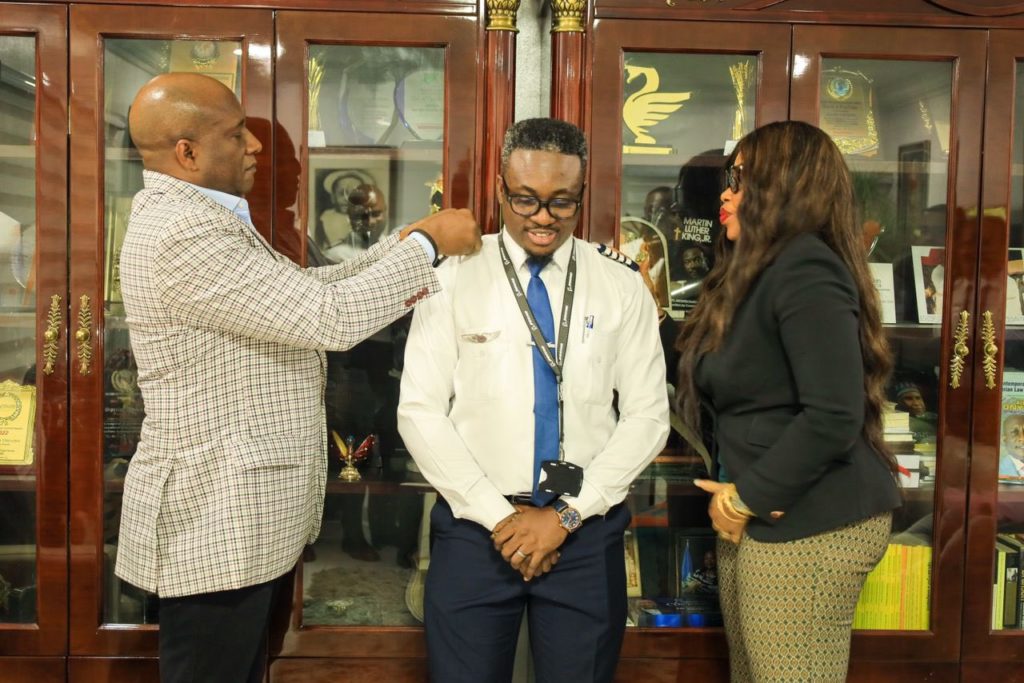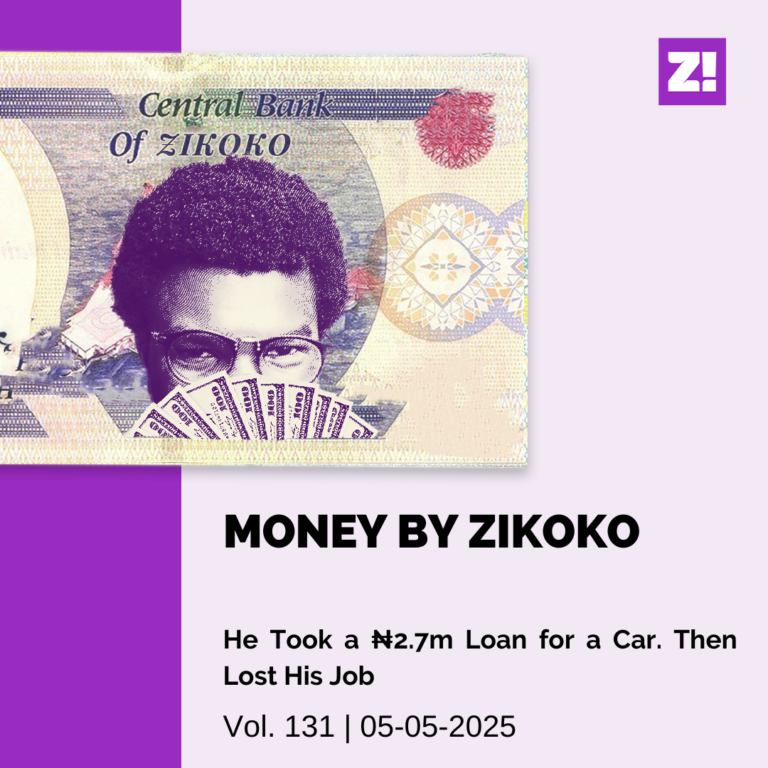Every week, Zikoko will share the hustle stories of Nigerians making it big in and out of the country. With each story, we’ll ask one crucial question in several ways: “How you do am?”

Let’s take it back to when you first thought about becoming a pilot
Random story. I didn’t grow up wanting to be a pilot; it just wasn’t in the realm of what was possible at the time. Civil engineering was a more realistic career choice, and that’s what I studied at the Federal University of Technology, Akure (FUTA). After graduating in 2009, I got a job with the China Civil Engineering Construction Corporation (CCECC) operations in Nigeria.
But something changed
From the moment I got the job, I started saving money for my Master’s Degree — a couple of universities in the UK and Canada were on my list. Three years later, I had saved enough to start the application process. But during a conversation with a mentor, they said, “Why don’t you go to flying school and become a pilot?”
And that was it?
For the most part, it was. My mentor had some flying experience, and I suspect that’s why he mentioned it. But it triggered something. I always loved planes and the physics behind them. It just never occurred to me to pursue a career in the aviation industry. Not until that moment.
Now, I had two options: go ahead with my plan for my master’s or go to flight school and transition into becoming a pilot. The thrill of the latter hooked me.
Haha. Just the thrill?
There was also the income potential. My research showed that I’d probably earn more as a pilot down the line than I could as a civil engineer. There was one more thing to consider though.
What?
The barrier to entry was steep. And it wasn’t just about the basic requirement — I had a university degree when a secondary school certificate was the minimum qualification I needed.
The primary barrier was the cost of getting a pilot license. I settled on an aviation school in Jordan, and when I enrolled in 2012, the fees were about $65k. That was a lot of money.
What about aviation schools in Nigeria?
They were cheaper, but there was no guarantee that I’d finish my training in good time if I explored a school in Nigeria. The biggest issue flight schools in the country face is aircraft availability. So I might have to spend three years in what was supposed to be a two-year programme. That didn’t sound appealing to me.
Jordan was the best option at that time. Thankfully, my mentor offered to pay for the bulk of the fees. I also had some savings and my mentor and family members chipped in the balance. With the fees sorted, I flew out of Nigeria to Egypt, and then to Jordan to start my training course. This was 2013.
Sweet. How did it go?
I paid for something called the Air Transport Pilot License (ATPL) training, which is the highest level of certification a pilot can get. There are two other certifications — the Private Pilot License (PPL) and the Commercial Pilot License (CPL). The PPL is the starting point, then the CPL. But no new pilot can leave the flight school with the ATPL.
Why not?
Every pilot needs a minimum of 1500 flight hours to qualify for the ATPL exam, and it unlocks the path to becoming a captain.
How many years did you spend in flight school?
A year and four months. I left with a CPL plus ATPL frozen license, which meant I had passed the theoretical exams, but I hadn’t fulfilled my flight hours requirements. I had 250 flight hours under my belt at the time.
Wait, what does “flight hours” mean?
It’s the number of hours a pilot spend in the air. It’s the aviation industry equivalent of “experience level.”
Ah, got it. What job options do 250 flight hours give you?
Not a lot. It certainly wouldn’t get me a job in Jordan, so I returned to Nigeria in 2015. Fortunately, my timing was perfect. Air Peace
What do you mean?
A pilot license only gets you one foot in the door. The next step is to get something called a type rating. It’s a certification that allows you to fly a specific type of aircraft.
Usually, baby pilots pay for this from their pockets. But because Air Peace was building their team, they sent me to Casablanca for my type rating and paid for it. At the end of my training, I was cleared to fly the Dornier 328 jet and started my new job as a second officer. This was 2015.
I’m curious. How do flight operations work?
There are two pilots in the cockpit on every flight: a Captain and the Co-pilot, and the latter’s rank is a Second Officer, First Officer or Senior First Officer. Now the Captain sits on the left and the Co-pilot sits on the right
The duties are shared between the two pilots, and we call this process “pilot-flying” and “pilot monitoring.” Essentially, it means one pilot is in charge of navigation and controls and the other assists and monitors their flight management.
The Captain decides if one pilot will fly the aircraft for the complete flight or if both pilots will take turns before the commencement of each flight sector. For example, the Captain can be the “pilot flying” during take-off and the co-pilot takes the role during descent and landing.
YOU SHOULD READ THIS TOO: The #NairaLife Of A Baby Pilot Managing A Million A Month
Whew. Tell me about your first flight as a commercial pilot
It was thrilling for the most part. But there was a nervy moment when my training Captain gave me the pilot landing duties when we were about to land the plane. That wasn’t a problem, but I thought he’d assist me. He didn’t.
I landed the plane all right, but boy, was I nervous. It took about two more flights before I built up enough confidence. I haven’t looked back since.
Whew. So what came after?
The only thing left to do was to work and gather more flight hours. I started my role as a Second Officer like every pilot in the early stage of their career does. The next milestone was being promoted to First Officer, and this happened after I clocked 800 flight hours.
By 2019, I had built my flight time to 1500 hours. Two things happened here: I returned to Jordan to complete my ATPL certification. Since I’d already passed the theoretical exams when I was in flight school, I only had to do and pass a series of skill tests to prove my proficiency. Then I got my certificate.
On the work front, an ATPL certificate and 1500 flight hours meant I had now fulfilled the requirements to be promoted to Senior First Officer.
The title means a lot of things, but most importantly, it means you’re a pretty good pilot and can now be on the path to making Captain.
Exciting. But I imagine there are other requirements
Absolutely. A Captain is the pilot-in-command and is responsible for the safety of the aircraft, crew and passengers. So it’s a big responsibility and multiple factors come into play to become one. The minimum requirement is 4000 flight hours. But you also need to have a spotless record, particularly with your competence, attitude to work and how you work with your team. Those cannot be in question.
I hit 4500 hours earlier this year, and the airline kicked off the process of making me a captain. Subsequently, I took a series of short courses and a simulator exercise, and that was it. In May 2023, I was decorated as a Boeing 777 Captain at Air Peace.

It took you eight years of active employment to get here
And those were very exciting eight years. At every point, there was always something to look forward to. Beyond getting promoted, I went for two other “type rating” exams between 2017 and 2019, which cleared me to fly the Boeing 737 and the Boeing 777. I also started flying international routes in 2019.
Well done. A lot of career growth is determined by how many hours you’ve spent in the year. How do you ensure that you’re not overworking?
Regulation takes care of that. A pilot cannot fly more than eight hours a day, thirty hours a week, 100 hours a month and 1000 hours in a year. A great day in the life of a pilot is simple — it means you take off and land your plane safely, and to a reasonable degree, these hour limits make sure of that.
Ah, sweet. What do you find most rewarding about being a pilot?
Access to multiple destinations and airports is quite an experience. My favourite airport to fly to is the Dubai International Airport. Also, the pay is enough to live a very comfortable life. It feels like I’ve recouped the money I invested in myself to go to flight school. I feel proud of myself when I remember that.
I’m not sure what my life would look like if I continued a career in civil engineering. But you know what? This one isn’t bad either.
So you can follow each drop, Hustleprint will be published in our money newsletter.




